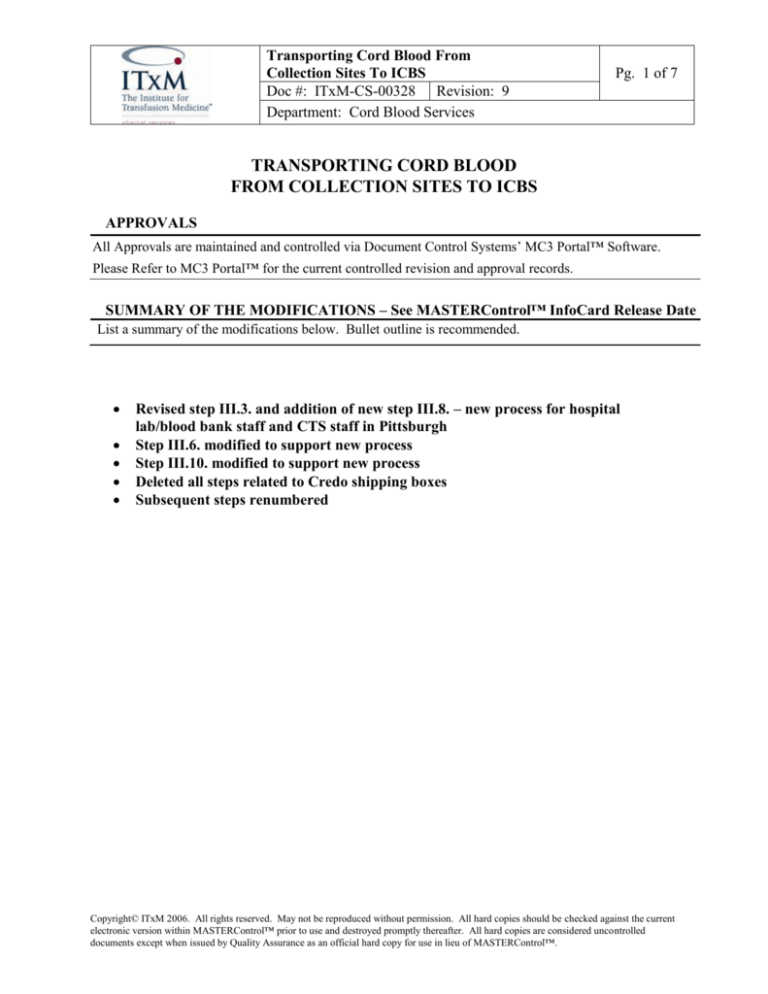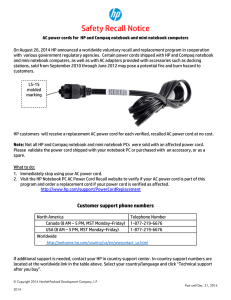
Transporting Cord Blood From
Collection Sites To ICBS
Doc #: ITxM-CS-00328 Revision: 9
Department: Cord Blood Services
Pg. 1 of 7
TRANSPORTING CORD BLOOD
FROM COLLECTION SITES TO ICBS
APPROVALS
All Approvals are maintained and controlled via Document Control Systems’ MC3 Portal™ Software.
Please Refer to MC3 Portal™ for the current controlled revision and approval records.
SUMMARY OF THE MODIFICATIONS – See MASTERControl™ InfoCard Release Date
List a summary of the modifications below. Bullet outline is recommended.
Revised step III.3. and addition of new step III.8. – new process for hospital
lab/blood bank staff and CTS staff in Pittsburgh
Step III.6. modified to support new process
Step III.10. modified to support new process
Deleted all steps related to Credo shipping boxes
Subsequent steps renumbered
Copyright© ITxM 2006. All rights reserved. May not be reproduced without permission. All hard copies should be checked against the current
electronic version within MASTERControl™ prior to use and destroyed promptly thereafter. All hard copies are considered uncontrolled
documents except when issued by Quality Assurance as an official hard copy for use in lieu of MASTERControl™.
Transporting Cord Blood From
Collection Sites To ICBS
Doc #: ITxM-CS-00328 Revision: 9
Department: Cord Blood Services
Pg. 2 of 7
PROCESS
SYSTEM
Recruitment/Collection, Information Management
CRITICAL CONTROL POINTS
Organizational Issues, Personnel Selection/Training/Education, Validation/Calibration/Quality
Control/PM/PT, Process Control, Documentation/Record Keeping, Error/Accident Review, Internal
Assessment, Process Improvement
PRINCIPLE
The viability of stem cells is adversely impacted by extreme temperature. ITxM Clinical Services Cord
Blood Services (ICBS) provides transportation guidelines to all collection sites to help ensure the safe
transport of cord blood collection from the hospital where it is collected to ICBS.
PERSONNEL
Cord Blood Staff – Technical/Non Technical
POLICY
I.
LifeSource Blood Services Customer Hospitals (Chicago area)
1.
Hospital Labor and Delivery staff should:
A.
Complete the "Delivered To Blood Bank By" line with name, date and time in
Part A of the Cord Blood Transfer Log.
2.
The hospital Blood Bank staff will accept cord blood donations from the Labor and
Delivery Suite and maintain at room temperature.
3.
Upon receipt, Blood Bank staff should
A.
Complete the "Received In Blood Bank By" line with name, date and time in
Part A of the Cord Blood Transfer Log.
B.
Call LifeSource Distribution to notify them they have received a unit.
(Distribution will assign a sample routing number to the unit and complete
Section I of the LifeSource Sample Routing Record.)
C.
Complete the "Transferred To ITxM By" with name, date and time in Part A
of the Cord Blood Transfer Log.
4.
LifeSource staff will provide the Routing Number to hospital staff. Blood Bank staff
will place the Routing Number on the outside of the collection bag and place in
designated LifeSource pick up space.
5.
LifeSource Distribution staff will pick up cord blood donations that are in the location
designated for LifeSource sample pick up on their routine stops at each hospital and
document the pick up in Section II of the LifeSource Sample Routing Record.
6.
The LifeSource driver will place the cord blood and specimens in a small Igloo cooler.
The donations will be transported in this cooler to maintain room temperature (to avoid
extreme weather conditions which may affect cell viability).
7.
The donations will be brought to LifeSource in Chicago at the completion of the driver’s
scheduled route.
8.
Upon arrival, the Product Distribution representative will complete Section III of the
LifeSource Sample Routing Record.
Copyright© ITxM 2006. All rights reserved. May not be reproduced without permission. All hard copies should be checked against the current
electronic version within MASTERControl™ prior to use and destroyed promptly thereafter. All hard copies are considered uncontrolled
documents except when issued by Quality Assurance as an official hard copy for use in lieu of MASTERControl™.
Transporting Cord Blood From
Collection Sites To ICBS
Doc #: ITxM-CS-00328 Revision: 9
Department: Cord Blood Services
9.
10.
Pg. 3 of 7
Upon Receipt in the Cord Blood Laboratory, a Cord Blood representative will complete
Section IV of the LifeSource Sample Routing Record as well as Section C of the Cord
Blood Transfer Log, and file them in the CBU chart.
ICBS does not hold the hospital Blood Bank nor LifeSource Distribution responsible for
lost, delayed or damaged routine cord blood donations that have been handled with
reasonable care.
II.
Non-LifeSource Service Hospitals
1.
Other hospitals that wish to participate in the cord blood donor program must make
arrangements to transport the donations to ICBS at the LifeSource Chicago facility or to
the Blood Bank of a LifeSource customer hospital that has agreed to store the donations
for pick up by the LifeSource Distribution staff.
2.
Specific Transport Guidelines as described in Section I, including labeling requirements,
will be provided to the transporting facility or individual.
III.
Western Pennsylvania Area Hospitals Serviced by CBB
1.
2.
3.
The Labor and Delivery Suite will maintain the CBU at room temperature until
delivery to the Blood Bank for shipment to ICBS.
Delivery room/collections staff will deliver the cord blood product, 3 maternal
sample tubes, and paperwork (signed Consent Form, Delivery Room Data Form, 3
Maternal Information/History Forms, and Cord Blood Transfer Log) to the
hospital blood bank.
Delivering the cord blood unit (CBU) to the hospital blood bank:
A.
The staff person delivering the cord blood to the blood bank will notify the
blood bank staff of the delivery, and the blood bank staff at the hospital
will confirm kit ID number listed on the Cord Blood Transfer Log is
present and all patient information in Part A is complete then complete the
line "Delivered To Blood Bank By" with name, date and time.
B.
If pneumatic tubing system (bullet system) in hospital is utilized, L&D
staff will prepare shipping of cord blood unit per hospital’s procedure of
shipping products to hospital lab/blood bank area.
1)
If pneumatic tubing system is received in lab area, lab staff person
will deliver the cord blood to the blood bank and notify staff of
delivery.
a)
Blood bank staff at hospital will confirm kit ID number
listed on the Cord Blood Transfer Log is present and all
patient information in Part A is complete then complete the
line "Delivered To Blood Bank By" with name, date and
time.
2)
If pneumatic tubing system is received in blood bank area, the
blood bank staff at the hospital will confirm the kit ID number
listed on the Cord Blood Transfer Log is present and all patient
information in Part A is complete then complete the line
"Delivered To Blood Bank By" with name, date and time.
Copyright© ITxM 2006. All rights reserved. May not be reproduced without permission. All hard copies should be checked against the current
electronic version within MASTERControl™ prior to use and destroyed promptly thereafter. All hard copies are considered uncontrolled
documents except when issued by Quality Assurance as an official hard copy for use in lieu of MASTERControl™.
Transporting Cord Blood From
Collection Sites To ICBS
Doc #: ITxM-CS-00328 Revision: 9
Department: Cord Blood Services
Pg. 4 of 7
4.
5.
Blood Bank staff will maintain CBU at room temperature at all times.
CBU should NEVER be refrigerated.
6.
Hospital blood bank staff will ensure cord blood, maternal samples, all paperwork and
Transfer Log are present with collection kit. Document name and date/time on Transfer
Log.
A.
Complete the line "Received In The Blood Bank By" with name, date and time in
Part A of the Cord Blood Transfer Log.
B.
Complete the line "Transferred To ITxM By" with name, date and time in Part A
of the Cord Blood Transfer Log.
C.
Place cord blood, maternal samples, all paperwork and Transfer Log in a transfer
box between 2 gel packs.
D.
Tape the box closed and label “CTS – CORD BLOOD PROGRAM.”
E.
As soon as possible, transfer Cord Blood products to CTS.
7.
Make sure cord blood, maternal samples, all paperwork, and Transfer Log are
present. If anything is missing, contact Labor & Delivery at the hospital to rectify
error before transport to ICBS.
Upon receipt of cord blood in transfer box at CTS, unpack cord blood unit from
transfer box.
A.
On Cord Blood Transfer Log inside collection kit, complete Part B with
name, date and time received in CTS.
B.
Place Transfer Log back into collection kit.
C.
Place collection kit inside platelet room at CTS in designated cord blood
box.
D.
Send transfer box back to appropriate hospital to be reused.
Weigh the cord blood. The cord blood product must weigh at least 75 gm to be
shipped for processing; if donor is a minority, the minimum weight is 70 grams.
A.
If the product is <75 gm and donor is not a minority, mark weight of cord
blood product on Cord Blood Transfer Log, discard cord blood and
maternal blood, and return all paperwork to Pittsburgh Cord Blood
Program Manager (located at D.L. Clark Building).
If the cord blood product is acceptable, CTS staff will pack the product for
shipping to Chicago.
A.
Make a copy of the Delivery Room Data form prior to packaging.
B.
Make a copy of the Cord Blood Transfer Log prior to packaging.
C.
Place copy of the Delivery Room Data Form and copy of Cord Blood
Transfer Log in bin (in BacT Lab) for Pittsburgh Cord Blood Program
Manager.
D.
Complete Part B of the Cord Blood Transfer Log, transferred to Cord Lab
with name, date and time.
8.
9.
10.
Copyright© ITxM 2006. All rights reserved. May not be reproduced without permission. All hard copies should be checked against the current
electronic version within MASTERControl™ prior to use and destroyed promptly thereafter. All hard copies are considered uncontrolled
documents except when issued by Quality Assurance as an official hard copy for use in lieu of MASTERControl™.
Transporting Cord Blood From
Collection Sites To ICBS
Doc #: ITxM-CS-00328 Revision: 9
Department: Cord Blood Services
11.
12.
Pg. 5 of 7
Primary shipping container is the Greenbox 12. If there are no Greenbox 12's
available, a commercial shipping box may be used.
A.
Measure temperature of dry incubator for Entropy Red Panels (Greenbox
12) before packing. Document the temperature, thermometer ID number,
tech ID on Dry Incubator Temperature Log.
Packaging of cord bloods for shipping:
A.
Greenbox 12 Shipping Container: Prepare 2 solid and 2 liquid panels for
each Greenbox 12 to be packed
1)
Preparation Process for Preparing Solid Entropy23 Red Panels:
a.
To solidify (2) Entropy23 red panels, place in the
refrigerator at 2-8oC for approximately 30 minutes until
solid.
b.
Once both panels are solid, they should be stored in an
environment where they stay solid (20-24oC). Use platelet
room for storing panels.
c.
Store solid panels together. Immediately prior to use check
the panels to ensure they are solid. If panels are not solid,
do not use. Re-solidify as in step 11.A.1.a.
2)
Preparation Process for Preparing Liquid Entropy23 Red Panels:
a.
If Entropy23 red panels are not in liquid state to start with,
place them at >25oC in the dry incubator in the BacT
Testing Lab.
b.
Panels should not be put in microwave oven.
c.
Entropy23 red panels should be stored in the dry incubator
in the BacT Testing Lab at >25oC.
d.
Remove the Entropy23 red panels and allow to come to
ambient room temperature (approximately 30 minutes)
before use.
3)
Packing Protocol for Greenbox 12:
a.
Open pre-assembled reusable Greenbox thermal shipping
container.
b.
Remove top Thermal-LOK insulation panel.
c.
Place first (solid) Entropy23 red panel in bottom of
Greenbox shipping container.
d.
Place one liquid Entropy23 red panel in Greenbox shipping
container directly on top of first solid Entropy23 red panel.
e.
Position cord blood products in payload box (cardboard
box marked Greenbox).
f.
Add cord blood paperwork and, if needed, fill around
payload with absorbent material to provide protection.
g.
Place closed payload box directly on liquid Entropy23 red
panel in Greenbox.
Copyright© ITxM 2006. All rights reserved. May not be reproduced without permission. All hard copies should be checked against the current
electronic version within MASTERControl™ prior to use and destroyed promptly thereafter. All hard copies are considered uncontrolled
documents except when issued by Quality Assurance as an official hard copy for use in lieu of MASTERControl™.
Transporting Cord Blood From
Collection Sites To ICBS
Doc #: ITxM-CS-00328 Revision: 9
Department: Cord Blood Services
Pg. 6 of 7
h.
13.
14.
15.
Place second liquid Entropy23 red panel in Greenbox
shipping container directly on top of payload box.
i.
Place second solid Entropy23 red panel in Greenbox
shipping container directly on top of second liquid
Entropy23 red panel.
j.
Replace top horizontal Thermal-LOK insulation panel with
seam facing up.
k.
Close top of Greenbox shipping container.
l.
Tape top of Greenbox shipping container where indicated.
B.
Commercial Box Shipping Container
1)
Charge two gel packs by placing in the refrigerator until solid.
Place in zip lock bags and place in 30-37oC water bath.
a.
When the transport temperature is expected to be above
50oF (approximately May through September), thaw the gel
packs for approximately 10 minutes. Remove from water
bath when gel packs are slushy.
b.
When the transport temperature is expected to be below
50oF (approximately October through April), thaw the gel
packs for approximately 15 minutes. Remove from water
bath when gel packs are liquid.
2)
Place absorbent material in the bottom of the cord blood shipping
box.
3)
Place a Lab Temp 40 temperature monitor on the cord blood
product, wrap in white absorbent material, and then place the
product in a zip lock bag.
4)
Place the cord blood product and the maternal samples in
absorbent material between the two charged gel packs.
5)
Place the gel pack/cord blood product package in a Jiffy bag and
tape the bag shut.
6)
Place the Jiffy bag in the prepared cord blood shipping box.
7)
Complete Part B of the Cord Blood Transfer Log “Transferred to
Cord Lab by” and “Date/Time.”
8)
Place all documents in the box on top of the Jiffy bag, including
the top copy of the Cord Blood Transfer Log.
9)
Place absorbent material on top of the paperwork and close the
box.
10)
Tape all seams on the shipping box with clear shipping tape.
Complete shipping label and affix to shipping box.
Place cord blood shipping package in hallway by CTS lab window for designated
courier to pick up.
Forward the bottom pink copy of the Cord Blood Transfer Log and a xerox copy
of the Delivery Room Data Form to the Pittsburgh Cord Blood Program Manager
(located at D.L. Clark Building).
Copyright© ITxM 2006. All rights reserved. May not be reproduced without permission. All hard copies should be checked against the current
electronic version within MASTERControl™ prior to use and destroyed promptly thereafter. All hard copies are considered uncontrolled
documents except when issued by Quality Assurance as an official hard copy for use in lieu of MASTERControl™.
Transporting Cord Blood From
Collection Sites To ICBS
Doc #: ITxM-CS-00328 Revision: 9
Department: Cord Blood Services
16.
17.
18.
IV.
Pg. 7 of 7
Upon receipt of product in the Cord Blood Lab, staff will evaluate the temperature
monitor on each product for acceptable temperature and complete Part C of the
Cord Blood Transfer Log.
Cord blood shipping boxes arriving at Chicago:
A.
If opening commercial box, utilize sharp instrument to cut through
packing tape.
B.
If opening Greenbox 12, pull packing tape off designated areas.
NOTE: Do not use a sharp instrument to open Greenbox 12 since this
will damage shipping boxes.
Transporting Empty Cord Blood Shipping Boxes to Pittsburgh:
A.
If sending commercial box to Pittsburgh, place separated gel packs
received back into box, seal with packing tape and send back to Pittsburgh.
B.
If sending Greenbox 12 to Pittsburgh, place all 4 red Entropy23 panels on
bottom of Greenbox, place empty payload box on top of red panels, place
Thermal-LOK lid on top of empty payload box, and close up Greenbox
and seal with packing tape where indicated.
Non LifeSource and Non CBB Serviced Facilities
1.
Other Hospitals that wish to participate in the cord blood donor program must
make their own arrangements to transport the donations directly to ICBS at the
LifeSource Chicago facility to CTS in Pittsburgh. ICBS will provide
transportation guidelines for those facilities providing their own transportation to
Chicago or Pittsburgh.
NOTE: Maternal samples can be packaged with cord blood or packaged
separately in shipping container.
AUTHOR
Linda Hahn, MPM, MT(ASCP)SBB
Copyright© ITxM 2006. All rights reserved. May not be reproduced without permission. All hard copies should be checked against the current
electronic version within MASTERControl™ prior to use and destroyed promptly thereafter. All hard copies are considered uncontrolled
documents except when issued by Quality Assurance as an official hard copy for use in lieu of MASTERControl™.






